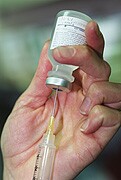| 
Estrogen May Have Preventive Role in Women's Schizophrenia
 MONDAY, Aug. 4 (HealthDay News) -- The estrogen estradiol, when combined with antipsychotic drugs, may help relieve psychotic symptoms in women with schizophrenia, an Australian study suggests.
It included 102 women of child-bearing age with schizophrenia. For 28 days, 56 of the women received 100 micrograms of estradiol daily via a skin patch, while the other 46 received a placebo via a skin patch.
The women's psychotic symptoms, including delusions and hallucinatory behavior, were assessed weekly, and those taking estradiol showed a greater improvement in symptoms.
The study was published in the August issue of the Archives of General Psychiatry.
Estrogen's neuroprotective and psychoprotective actions may be mediated by a variety of routes, ranging from rapid actions, including antioxidant effects and enhancement of cerebral blood flow and cerebral glucose utilization, to slower, genomic mechanisms, which may include permanent modification of neural circuits, the study authors wrote.
The lack of effect for negative symptoms is consistent with literature reporting that negative symptoms are less responsive to treatment than other symptoms of schizophrenia. It is possible that longer-term treatment is required for negative symptoms to respond to treatment. Alternatively, brain regions implicated in negative symptoms may be less responsive to gonadal hormone effects.
The study authors said estrogen may have a preventive role in women with schizophrenia who have childbirth- or menopause-related hormonal changes known to cause a deterioration of their condition.
"Estrogen treatment is a promising new area for future treatment of schizophrenia and potentially for other severe mental illnesses," they concluded.
More information
Mental Health America has more about schizophrenia  . .
|  |

Viagra May Boost Female Libido in Some Cases
 TUESDAY, July 22 (HealthDay News) -- The drug that turned around the sex lives of many older men has proven in a small trial to also help women on antidepressants who experience sexual dysfunction.
The eight-week study found that Viagra, also known as sildenafil, helped women achieve orgasm.
"In this study population, sildenafil treatment of sexual dysfunction in women taking SRIs was associated with a reduction in adverse sexual effects," the study's authors wrote.
Results of the study are in the July 23/30 issue of the Journal of the American Medical Association. The lead author of the study, Dr. H. George Nurnberg, of the University of New Mexico School of Medicine, in Albuquerque, declined to be interviewed for this article.
Selective and nonselective serotonin reuptake inhibitors, such as Prozac, Paxil, Zoloft and Effexor, comprise up to 90 percent of the 180 million antidepressant prescriptions filled in the United States each year, according to the study. But while these medications are very effective at treating clinical depression, one of their known drawbacks are sexual side effects.
Nurnberg and his colleagues previously reported in the Journal of Clinical Psychiatry, that Viagra was helpful for men who suffered from erectile dysfunction associated with the use of antidepressant medications.
In the current study, undertaken at seven research centers, they turned their attention to women. The study included 98 women -- half of whom received Viagra and half who received a placebo -- who were told to take the pills before sexual activity.
Women taking Viagra reported an improved ability to reach orgasm and increased orgasm satisfaction, according to the study authors.
But 43 percent of the women taking Viagra also reported headaches, versus 27 percent of those on placebo. Almost one-quarter of those using Viagra reporting flushing, while none of the women on placebo did. And 37 percent of women taking Viagra reported nasal congestion compared to 6 percent of women on placebo. Nausea and anxiousness were reported more often in the group taking placebo.
"The libido response in women is such a complex problem. If women are unhappy in a relationship, it can affect libido. If it hurts, it can affect libido. If she doesn't feel good about herself, it can affect libido. It's hard to tease all of those factors out," said Dr. Judi Chervenak, a reproductive endocrinologist at Montefiore Medical Center in New York City.
And, she added, "There's no definitive answer to date on how antidepressants cause a lack of libido. It could be because they're affecting dopamine, and women may be experiencing changes in dopamine that indirectly affect vaginal lubrication and arousal and cause decreased blood flow."
Of the current study, Chervenak said, "It's an enticing study, and it makes me want to know more. Does it make me want to prescribe Viagra right off the bat? Not at this point. I'd suggest first that patients keep a symptom diary, so we can figure out what their issue is. Is it arousal? Is it decreased blood flow? Is it an orgasm problem?"
"Another possibility might be to work with their psychiatrist," she added. "Would it be better to change the antidepressant or to taper the dose? What about a drug holiday? Although you have to be careful, and people can't do that on their own, because there can be potentially devastating problems if you come off these medications too quickly."
"This study has opened up many questions, and hopefully, we'll learn more in the future," concluded Chervenak.
Meanwhile, a spokeswoman for Pfizer, which manufactures Viagra, told the Associated Press that the company has no plans to seek approval for using the drug as a treatment for female sexual dysfunction. The company ended its own research on Viagra for women in 2004, she added.
More information
To learn more about antidepressants and their potential side effects, visit the National Institute of Mental Health.
|  |

Baby's Smile Lights Up Mom's Brain

MONDAY, July 7 (HealthDay News) -- Science may have confirmed what most moms already know: When a woman sees her baby smile, certain areas of her brain activate, stimulating happy feelings.
"There's a definite biological origin to these feelings that mothers have," said study author Dr. Lane Strathearn, an assistant professor in the department of pediatrics at Baylor College of Medicine in Houston. "The contrast that showed the most response in the dopaminergic system of the brain was when a mother's own baby smiled compared to an unknown baby face."
"A baby's smile is a very powerful stimulus," noted Strathearn. "It makes sense biologically. Babies are completely and utterly dependent on their caregivers. It makes sense that nature would build in a system that would reinforce that relationship."
A woman's crying infant, or even her baby with a neutral expression, doesn't evoke the same type of brain response as occurs when her baby is smiling, the study found.
Strathearn said they haven't had a chance to look at the effects on fathers. His team published its findings in the July issue of Pediatrics.
For the study, the researchers recruited 28 first-time mothers during their last trimester of pregnancy. At that time, Strathearn said the women completed "attachment interviews" to assess the types of experiences they had when being raised and what type of relationship these mothers had with their own parents.
The average age of the women was 29, and most had at least a college degree. Thirteen of the women were white, seven were black, four were Hispanic, and four listed their race as other. Most of the women -- 20 -- were married.
Then the researchers met with the mothers and the babies when the babies were about 6 months old. At that time, they videotaped them and captured smiling, crying and neutral pictures of the babies. When the babies were about 10 months old, they asked the mothers to come back in for a functional MRI (fMRI) scan that shows which areas of the brain are activated.
When the mother's saw photos of their own baby's face, an extensive brain network was activated, according to the study. But, it was when mothers saw their own infant's happy face that the dopaminergic reward system in particular was activated. This system was not activated when mothers saw their own children looking either sad or neutral.
"This study is fascinating. It's a step towards unraveling the chemistry of emotion, and it begins to show the complex chemistry of the mother-child relationship," said Dr. Michael Wasserman, a pediatrician at Ochsner Health System in New Orleans.
Strathearn explained that for some mothers, there may be a problem in this natural reward system, and that may help to explain why some women never bond with their children or even abuse their children.
More information
The Nemours Foundation has more on bonding with your baby  . .
|  |

Breast Cancer Vaccines Look Promising

THURSDAY, June 26 (HealthDay News) -- Women with metastatic breast cancer who developed an immune response to an investigational vaccine lived twice as long as those who didn't have an immune response, new research shows.
"If you were an immune responder, you had double the survival of a non-responder," said study author Dr. Susan Domchek, an associate professor of medicine at the University of Pennsylvania.
Her report is one of several focusing on breast cancer vaccines expected to be discussed this week at the Department of Defense Era of Hope breast cancer research meeting, in Baltimore.
"Metastatic breast cancer is treatable but not curable," Domchek said. While the ultimate hope is to cure the cancer, breast cancer vaccines are one possible way to try to control the disease's spread.
Although most people think of vaccines as shots given to healthy people to prevent infectious diseases such as measles and the flu, various cancer vaccines that have been studied for decades use cancer cells, parts of cells or substances called antigens to trigger an immune response against cancer cells already in the body.
In her study, Domchek used pieces of a protein called human telomerase reverse transcriptase (hTERT) peptide to vaccinate 19 women with breast cancer that had spread. The peptide is nearly universally overexpressed in human cancers and is recognized by certain T-cells in the body's immune system.
At the start of the study, the women had no measurable T-cell response to hTERT. After up to eight vaccinations with the hTERT peptide, however, 13 of the 19 women made T-cells that reacted to the peptide.
"We biopsied the patients' breast cancer and saw that we could see these T-cells in the tumors themselves," she said. "And, in some cases, we could see evidence of tumor cells' death."
"Those who responded lived significantly longer," she said. "People who responded lived 32 months versus a median of 17 [for those who did not respond]. Three of the women who were responders have lived more than three years."
Among the questions that remain, however, said Domchek, is this: "Were those women going to do well no matter what we did? Is immune response just a marker for a healthier patient?"
Other research on breast cancer vaccines expected to be presented at the meeting include:
- A study that focused on breast cancer patients with HER-2-positive tumors (for whom relapse is common after treatment) treated with a combination of vaccine plus an anti-cancer drug. Dr. Lupe Salazar, an assistant professor of medicine at the University of Washington, in Seattle, and her team sequenced the HER-2 protein and put pieces of it into a vaccine. They gave it to patients, along with the anti-cancer drug Herceptin. The combination helped to generate significant levels of T-cell immunity specific to the HER-2 cells, she said. As of now, "all eight [women] have done this," she said. The study will eventually include 52 women.
- A study that uses immunostimulatory peptides as a vaccine looked at the best way to deliver them. Dr. Davorka Messmer, an assistant project scientist at the Moores Cancer Center at the University of California San Diego, and her team tested a vaccine using nanoparticles loaded with the HER2 peptide that carry an immune system-stimulating peptide, called Hp91, on the outside or the inside. "We found it more potent if the immunostimulatory peptide was put on the surface of the nanoparticle," she said. The study was conducted in animals.
While breast cancer vaccines have been studied for at least 30 years, they have yet to make a real difference in the lives of patients, said Dr. Len Lichtenfeld, deputy chief medical officer of the American Cancer Society. That's not to say they won't someday, he added.
"When you look at the theory, it makes sense," he said. "The bottom line is, we are getting there, but [we're] not there yet."
Many questions remain, he said, such as "why some patients have immune responses, and others don't." It is likely, he said, that some of the vaccines will be specific to one cancer, and others may work on more than one type of cancer.
More information
To learn more about breast cancer vaccines, visit the breastcancer.org  . .
|  |
|